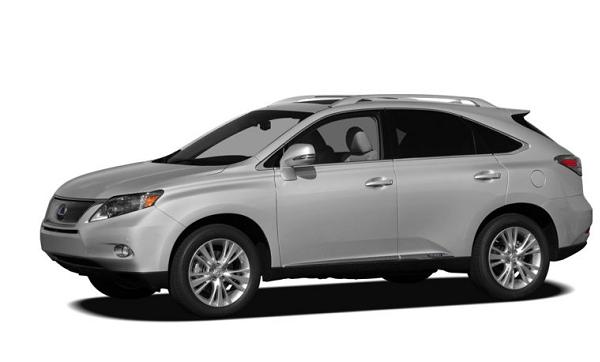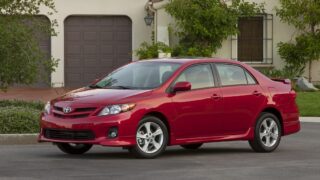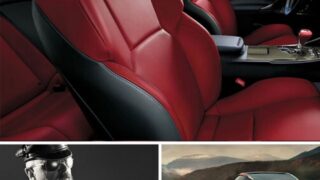2010 Lexus RX Review – Driving Impressions

By John Stewart [NewCarTestDrive]
Over the period of two days in Sonoma, California, we had the
opportunity to switch in and out of standard a RX 350, both with
front-wheel drive and all-wheel drive, plus an RX 450h hybrid, and a
brief drive in the current RX 330. We spent most of our time in a
Matador Red RX 350 AWD with the Navigation package.
Out on the road, the big V6 in the RX 350 responds well to throttle.
Part of that is the new six-speed transmission, which has a lower
first-gear ratio than the old five-speed, so it gets the RX quickly up
to speed for merging or highway entry. Lexus told us to expect 0-60
times in the neighborhood of 7.4 seconds, and a quarter mile time of
15.8, and that’s about the way it felt. We didn’t go there, but top
speed is electronically limited to 112 mph.
The transmission quickly selects gears based on throttle input, so you
can ask for a gentle downshift just by giving it a little more gas. If
you floor the accelerator, it kicks down two gears and moves out. It’s
also possible to select your own gears in multi-mode shifting, but the
automatic’s logic seemed so intuitive that we would probably drive in
Auto 95 percent of the time, using the manual mode for downhill control
on the highway or long uphill when heavily loaded. There is no V8
option for the RX, but if there were, we’d wager that performance would
not be much improved, and mileage would suffer.
We did not feel much torque steer in the front-wheel-drive models, and
particularly, the hybrid. Full-throttle starts in the previous hybrid
elicited a waggle as various components of the powertrain kicked in
that we found disconcerting. First, you’d feel the engine, then two
electric motors, one after the other. These steering affectations are
far better tamed in the new RX 450h. Our assumption is that the
transmission’s computer is managing torque more progressively, and the
flywheel is more heavily damped.
The RX 350 is not built for road racing, but more for passenger
comfort. The new rear suspension, a double-wishbone independent, has a
lot to do with that. Still, it has a nice, clean turn-in and good
lateral grip for an SUV. The new RX is just a little longer than the
old model, and stands 2.6 inches wider, so there is a noticeable gain
in agility.
We expect Lexus vehicles to be exceptionally quiet, and the new RX is
no exception. That said, the 19-inch wheels on the Sport Package do
allow for more road input, and a little more noise and vibration seep
through. The suspension is tuned slightly differently with the Sport
Package, but the end result is still not as aggressive as Porsche’s
Cayenne or the BMW X5. To us, that’s fine. We think SUVs are better at
grocery-getting than corner-carving anyway. Bigger wheels, thinner
tires and tighter damping tend to compromise Lexus ride quality and
noise control, without delivering all that much gain. So our preference
is for the 18-inch wheels.
Regardless of the tire choice, we found it easy to maintain a
conversation using a low tone of voice at normal speeds. Lexus
pioneered the science of quietness in a car, with the result that
almost all cars are significantly quieter than they were five years
ago. New tricks, such as optimized wheelwell damping coatings and
fender liners, have been incorporated into the new RX. The underbody of
the car has also received attention against wind noise. And the
addition of a sixth gear in the transmission has allowed for quieter
cruising, with less engine noise, on the highway.
All those things also hold true for the RX 450h, but because it is a
hybrid, it regularly operates with the engine off altogether. During
those times, noise reduction is even greater, bordering on eerie.
The brakes feel strong and progressive, with just a little squish at
the top of the pedal before stronger grip kicks in. The hybrid brakes,
which are regenerative, are now much more smoothly modulated than early
hybrid brakes. The transition between light braking, when the generator
reclaims power, and the serious stopping power that comes on when more
pedal is applied, can still be felt, but you have to look for it.
Steering effort is light, but seems better proportioned than past
electric steer-by-wire systems we’ve tested. It’s more accurate than
before, especially at the center. The new power-assist logic is based
on vehicle speed. The slower you go, the less effort required, so it
can be just as appropriate in the parking lot as in the fast lane on
the way to Las Vegas. Lexus uses the electric steering system on a
number of its vehicles, because it reduces drag on the motor and thus,
improves fuel economy. It’s also more compact, so there are packaging
advantages, and once you have a computer controlling steering, you can
add VDIM.
VDIM is not a system easily tested in normal driving, because it
requires driving out of control, and then recovering. At which point,
nothing will have happened, except maybe a brief flash of an icon on
the dash. But it’s a system that looks at steering, braking, throttle
and motion sensors in the cabin to predict what will actually happen,
compared to what the driver is asking for. If there is any difference
between the two, the system intervenes and selectively brakes
individual wheels to correct the path of the car. It happens so fast
you might not notice.
We’ve tested VDIM on race tracks and lonely dirt roads. It works
without slowing down the car much, unlike VSC, which is the standard
traction/stability control system. It’s an expensive option, but one we
wish was on every car.
The RX is an easy SUV to see out of, and fairly easy to keep track of
the area around the vehicle when backing up or parking. Driver
visibility is enhanced by small windows in the A-pillar, and by small
TV cameras that track the rear and passenger-side of the RX. One camera
is located in the right side mirror, the other in the rear bumper. We
found we could toggle between the two views, front and side, to see how
close we were to the curb or pedestrians.
We found the RX to be a relaxed and comfortable ride, so we spent time trying out some of the new electronics systems.
We actuated the heads up display and found it makes it easy to stick to
speed limits in unfamiliar ground. Bright white, high-contrast figures
were easy to read, even heading into sunlight. It’s the best we’ve seen
so far. It’s possible to project the display anywhere on the
windshield; we liked it best low and to the left.
Voice recognition, something we’ve never really trusted, still takes a
little getting used to, but the new system is much closer to something
we might use every day. We began by asking it to switch to channel 143
on XM, which it had no problem doing. It also seemed to quickly be able
to supply the nearest gas stations, although not the cheapest prices,
and turn down the air conditioning. However, when we asked it to play
Grateful Dead, it did not find the channel on its own, so evidently
there are limits to Hal’s intelligence.
The RX 450h is offered in front-wheel drive or all-wheel drive, but the
all-wheel-drive system is different; it incorporates a separate rear
electric motor to power the rear wheels. Because it is a hybrid, the
transmission is a continuously variable automatic and the brakes are
different due to the need to regenerate electricity. And there are a
few packaging and styling differences to consider when making a
decision between the two. Because of the addition of electric motors,
the RX 450h has 20 more horsepower than the RX 350, which compensate
for a weight penalty of about 300 pounds.
From a purely economic point of view, the hybrid becomes attractive if
you believe the cost of fuel will again rise sharply. The hybrid RX
gets about 7 mpg better fuel economy, so it goes 134 miles farther on a
tank of gas. That translates into a savings of $12.80 per tank if gas
stays at $2 per gallon, or $25 per fill-up if gas goes back up to $4
per gallon. If the premium for the hybrid system is $4000, you would
have to drive 83,700 miles before the cost is amortized. Over 100,000
miles, you would burn almost 1200 gallons less gas, but save only $786.
In short, dollar savings would be modest, even if prices rise. For that
reason, most current hybrid buyers chose the vehicle because they want
to drive the most fuel-efficient, cleanest SUV possible, one that
reduces dependency on imported oil. The new RX450h takes that reasoning
further, delivering up to 12 percent better fuel economy and 27 more
system horsepower than the current-generation RX 400h hybrid. Total
emissions are approximately the same as the current RX400h, even though
the 450h has a bigger engine and more power. Which is to say extremely
low.
The RX 450h we drove averaged 23.4 mpg over 120 miles of mostly around-town driving.
The hybrid brake system uses the same ventilated four-wheel discs in
the RX 350, but has an electronically controlled regenerative brake
feature that charges the batteries when the brakes are applied gently.
The hybrid system includes ABS, Electronic Brake-force Distribution
(EBD), Brake Assist and more important, Vehicle Dynamics Integrated
Management system (VDIM) as standard equipment. We’ve tested VDIM on
controlled proving-grounds settings, and consider it a remarkable
safety system. It’s also available on the RX 350 as an option.
The hybrid can drive in three modes: Normal, Eco for best mileage, and
EV Mode which allows the vehicle to operate on battery only. Lexus tech
sources estimate the EV-only mode operating distance at about a mile.
The EV feature is aimed at allowing the RX to be used as an electric
car in closed urban areas where internal combustion engines are banned
altogether, such as in Europe.




